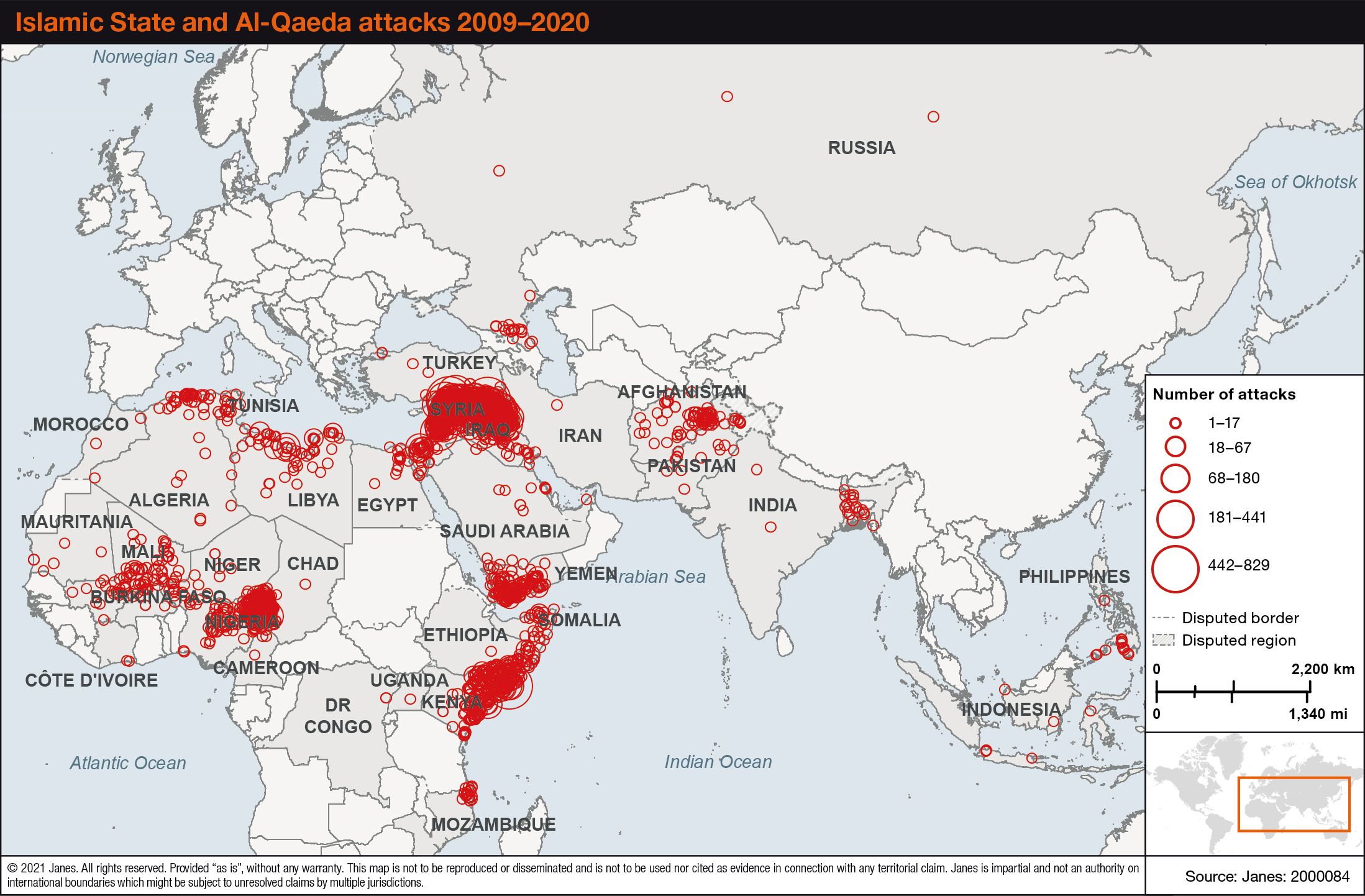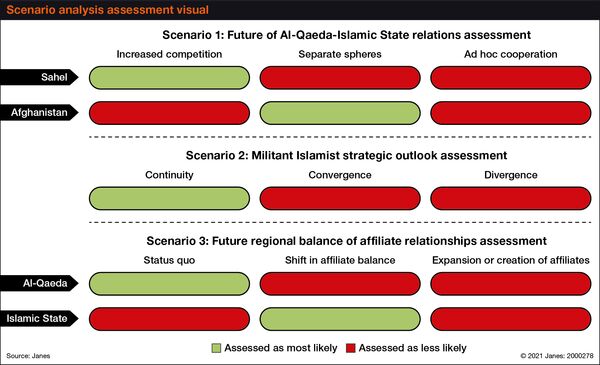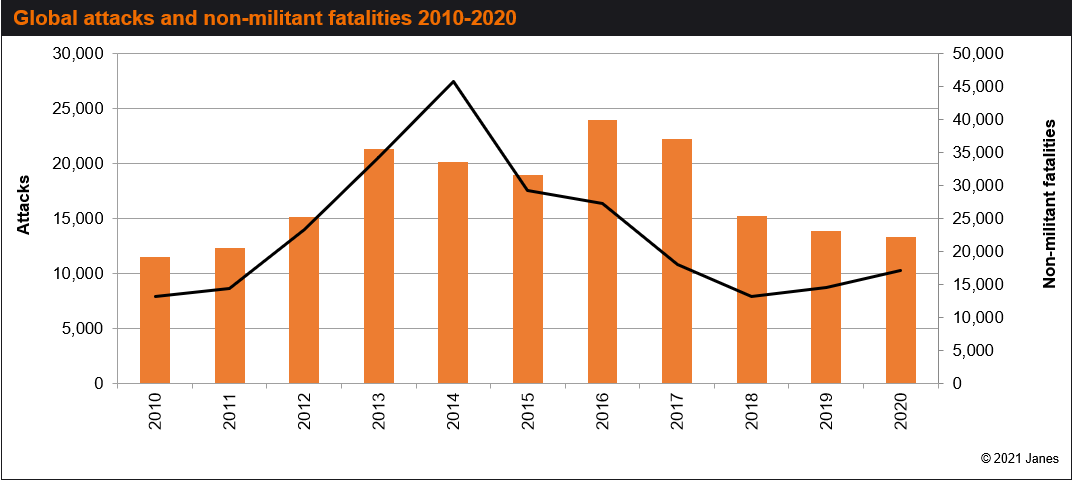- About
- Intara
- Capabilities
- Advisory
- Resources
- News
- Store
Enemy-initiated attacks in Afghanistan continue at high level
01 February 2021
by Gabriel Dominguez
The number of enemy-initiated attacks (EIAs) in Afghanistan continues at a high level, especially in Kabul where US Forces-Afghanistan (USFOR-A) have reported an uptick in targeted assassinations of Afghan government officials, civil-society leaders, and journalists in recent months.
20 years after 9/11: The evolving transnational militant Islamist threat landscape
08 September 2021
by Janes Terrorism and Insurgency Centre
Two decades have now passed since Al-Qaeda militants targeted the United States mainland on 11 September 2001. Since the attacks, the fight against transnational militant Islamism has dominated security agendas in the US, Europe, and beyond, costing the US alone over USD 5.4 trillion and claiming the lives of more than 7,000 US military personnel globally. Despite these costs, the threat from militant Islamism has persisted – and indeed proliferated – since September 2001. At this 20-year mark, Janes Terrorism & Insurgency Centre (JTIC) data offers insights on past trends and future forecasts for transnational militant Islamist activity.
Operational trends
Al-Qaeda and the Islamic State represent the most active transnational militant Islamist groups since 2001. According to JTIC data, these groups and their affiliates conducted at least 27,258 attacks between 2009 and 2020, resulting in over 61,124 non-militant fatalities. These attacks have largely targeted conflict theatres in the Middle East – with more than two-thirds of attacks taking place in Syria and Iraq – as well as in East Africa and West Africa. Transnational Islamist violence has targeted security forces in over half of all attacks, and militants have demonstrated a tactical preference for close-quarters engagement between forces on open ground and stand-off/area attacks involving explosives or indirect fire attacks.

When comparing the operational profiles of Al-Qaeda and the Islamic State, Al-Qaeda has conducted far fewer attacks and its tempo of violence has been steadier than that of its rival. Wilayat Gharb Afriqiyya (West Africa province) was the Islamic State’s most operationally active affiliate in 2020, while Harakat al-Shabaab al- Mujahideen was the Al-Qaeda affiliate that conducted the most attacks in that year. At least 127 inter-group clashes between Islamic State and Al-Qaeda forces were recorded between 2009 and 2020, with the majority taking place in Syria in 2014 and 2015. With 37 lone actor attacks recorded between 2009 and 2020, JTIC data indicates that the Islamic State inspired far more of these attacks than Al-Qaeda, and that most of this activity has been conducted in Europe with edged or improvised weapons.
Regional forecasts
Based on JTIC data for the first half of 2021, JTIC presents the following regional forecasts for the remainder of 2021:
Lake Chad/Sahel: Attacks and non-militant fatalities are likely to increase because of factors including the 24 May coup in Mali, drawdown of French military forces, the death of Chadian President Idris Déby, and the likely reconciliation of dissident and mainstream factions of Wilayat Gharb Afriqiyya after the death of dissident leader Abubakar Shekau.
Mozambique: A lower tempo of violence is likely to continue in the short term, with Wilayat Wasat Afriqiyya (Central Africa province) attacks having decreased significantly in Cabo Delgado province in early 2021 in contrast to 2020. Smaller-scale raids are likely following the recapture of Mocimboa da Praia by security forces in August, though militants may exploit security gaps after the Southern African Development Community’s (SADC) withdrawal in October.
Syria: Islamic State attacks in 2021 appear set to outpace those recorded in 2020, with militants having already conducted 80% of the total number of 2020 attacks in the first half of 2021 alone. Recent operational trends indicate that attacks will continue to target security forces, with an increasing focus on ambush tactics.
Iraq: Islamic State militants are likely to continue to conduct asymmetric, low-casualty attacks in rural areas and – in future summers – will likely continue to exploit high temperatures to disrupt essential services, provoke popular unrest, and undermine the government in Iraq through sabotage attacks.

Policy implications
Counter-terrorism priorities today are starkly different to those immediately after the September 2001 attacks, when there was a surge of counter-terrorism investment in the US, Europe, and beyond. US counter-terrorism activities focused on long-term overseas operations, militarised responses, and leadership decapitation, with a lesser focus on tackling the drivers of militant recruitment and radicalisation. In the early 2020s there has been a marked shift toward reducing military commitments overseas, with US forces withdrawing from Iraq and Afghanistan, and France signalling a drawdown of its military presence in the Sahel. While boots remain on the ground in key conflict zones, the US and its Western partners are increasingly seeking to support, rather than lead, overseas counter-terrorism efforts.
An analysis of security responses since September 2001 offers insights for policy and practice. As the 20-year anniversary of the September 2001 attacks approaches, counter-terrorism professionals face a diversified threat landscape and an expanded set of policy priorities. Despite shrinking counter-terrorism budgets, there is a continued need to support overseas partners to preserve the gains of the last two decades and prevent the emergence of future transnational threats. The last 20 years have signalled that over-reliance on short-term, militarised responses without commitment to strengthening local governance and addressing underlying drivers of radicalisation can limit the effectiveness of security responses. Technological advances and high volumes of open-source information also call for streamlined inter-agency coordination, investment in artificial intelligence and machine learning capabilities, and continuous monitoring of the threat environment.
This forms the executive summary of our terrorism and insurgency centre's deep dive into the evolving transnational militant Islamist threat landscape. For the full report, subscribers can log in here.
Killing of Chadian President Déby likely to threaten domestic and regional stability
21 April 2021
President Idriss Déby Itno was wounded by Front pour l'Alternance et la Concorde au Tchad (FACT) militants during clashes in Chad’s Kanem province on 19 April 2021. In an address on state television channel Télé Tchad, army spokesperson General Azem Bermandoa Agouna announced that the President had been evacuated by his son, Mahamat Idriss Déby, to the capital N’Djamena on the day of the clashes, but succumbed to his injuries one day later. Following Déby’s death, the army announced that his son would lead an 18-month transitional military government. However, this was rejected by the opposition, most of which had also abstained from voting in the April election, demonstrating ongoing political schisms in the country.
FACT
FACT is a Libya-based militant group founded in 2016 as a dissident branch of the Union des forces pour la Démocratie et le Développement (UFDD) with the aim of enforcing political change in Chad. It is led by Mahamat Madhi Ali, who stated in a 2016 interview with Jeune Afrique that his main goal was to remove President Déby from power through force. Ali claimed that the group comprised 700 militants, all of Chadian nationality, and that the group’s main base was located in Chad’s Tanoua region, with a training centre of 350 men located in Djebel Saoudah in southern Libya.
FACT incursion
President Déby had gone to the frontline to support the military after FACT militants, based across the northern frontier in Libya’s Fezzan region, had advanced hundreds of miles south towards Chad’s capital, launching an incursion on the day of the presidential election. On 11 April, FACT claimed that it had taken control of garrisons, including Wour and Zouarke, “without resistance” from Chadian security forces in the northwestern Tibesti region. This prompted the army to announce that it had “decimated” the militants that had entered the country on 11 April. In a statement published on the militant group’s Facebook page on 18 April, FACT condemned “the electoral charade that took place in Chad amidst an entirely toxic political climate that was far from conducive to the organisation of a democratic, free and transparent election”, and demanded “the immediate cessation of this ongoing electoral robbery in order to put in place a political transition inclusive of all the political forces, civil society and the Diaspora”. In a separate statement that day, the group’s military wing announced that it had “liberated” Kanem province.
Subscribers can read the full article by logging in.
Interested in subscribing? See What we do.
Deadly threats persist: deaths from terrorist activity up 20%, says Janes
09 March 2021
2020 full-year terrorism figures from Janes highlight 2,543 more deaths in 2020 from terrorist activity than in 2019 – despite operational activity slowing down.
LONDON (9 March) – Data from the 2020 Global Attack Index by Janes, spanning the entirety of 2020, demonstrates a total of 17,122 non-militant deaths in 2020 resulting from attacks by non-state armed groups (NSAG), a 17.4% increase from 2019. Despite this, information from the trusted global agency for open-source defence intelligence recorded a 3.7% decrease in attacks – with 13,310 attacks by NSAG recorded from open-sources.
“The overall downturn in attacks can be largely attributed to the July ceasefire in Ukraine’s Donbass region, which resulted in attacks dropping by one-third in the high-tempo separatist conflict,” said Matthew Henman, head of Terrorism and Insurgency at Janes. “This decrease masked major shifts in violence in Afghanistan and key conflict zones in sub-Saharan Africa, though, where attacks and resultant fatalities rose dramatically.”
Deadlier than ever: rise in attacks in Afghanistan propels it to top spot
In 2020, Janes recorded 2,373 NSAG attacks in Afghanistan – making it the most dangerous country in terms of attacks recorded. Concurrently, it also took the spot as the deadliest country, with the 6,617 fatalities recorded by Janes representing a 15.9% increase from the annual total recorded in Afghanistan in 2019.
“The fatality total accounted for more than one-third (38.6%) of all non-militant fatalities worldwide, and was higher than the cumulative total of the next six deadliest countries,” said Henman. “Across 2020, the most attacks were recorded in Afghanistan – while the country, coupled with Syria and Ukraine, cumulatively accounted for more than half of all attacks worldwide.”
Janes notes that the increasing violence in Afghanistan was driven almost exclusively by Taliban attacks targeting the security forces, following a peace deal signed with the US government in February 2020.
“The Taliban further challenged the Afghan state for control of territory across the year, “as the group pushed to both degrade security force capabilities and further strengthen its position for nascent peace talks with the government,” said Henman.
“Attacks in Syria and Ukraine decreased by 29.1% and 36.5% respectively between 2019 and 2020, both offsetting the significant rise in Afghanistan and somewhat accounting for the overall decrease in attacks. Interestingly, there was a 50% increase in attacks recorded in Iraq, rising to 1,466 in 2020.”
Islamic State – pending resurgence in the heartlands
“The increase in attacks in Iraq was largely driven by the Islamic State’s Wilayat al-Iraq, or Iraq province, which accounted for half of all recorded Islamic State attacks worldwide in 2020. Low-level asymmetric operations by the group rose in tempo across the year, alongside periodic mass-casualty attacks, underlining the slow but steady resurgence of the group following its territorial defeat in Iraq in November 2017” said Henman.
Janes data shows that attacks by the Islamic State rose 2.9%, indicating a degree of stabilisation following consecutive years of decreasing attack totals since 2016, while fatalities resulting from these attacks grew by 16.8%.
“The rise in fatalities was principally a consequence of mass-casualty operations conducted by the Islamic State’s West Africa province in the Lake Chad basin and the tri-border Sahel area,” said Henman. Janes also recorded a significant increase in operational tempo by the Islamic State’s Central Africa province in northeast Mozambique, where local militants continued to challenge the security forces for control of key urban and commercial locations in Cabo Delgado province.
ADF drives massive rise in DRC violence
Across 2020 in the Democratic Republic of Congo, Janes recorded double the number of attacks from 2019, while resultant fatalities more than tripled. Indeed, the DRC was second only to Afghanistan in terms of recorded non-militant fatalities in 2020.
Janes data shows this major increase in both attacks and fatalities was driven by the Allied Democratic Forces (ADF), which conducted repeated attacks on the civilian population in the provinces of Nord Kivu and Ituri.

The number of enemy-initiated attacks (EIAs) in Afghanistan continues at a high level, especially in...
Latest Podcasts
Iran Israel analysis
In this podcast Janes analysts discuss the Iranian attacks on Israel on the 14 April. They highlight the military systems used by Iran and the performance and impact of these on Israel. They also discuss the implications of this attack goi...
Listen nowJanes Case Studies
Using Janes Intara to build a common intelligence picture: Russian build up on the Ukrainian border
View Case StudyNews Categories
 Security Details
Security Details 